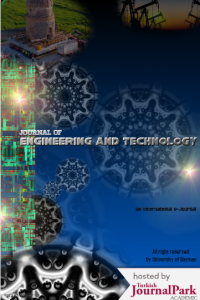Life-Cycle Environmental Footprint Analysis of Electricity Generation Technologies
Life-Cycle Environmental Footprint Analysis of Electricity Generation Technologies
Increasing urbanization and global population, in addition to huge economic and industrial developments have jointly led to raised consumption of electrical. With the rise in fossil-based fuel costs and the environmental awareness to decrease greenhouse gas emissions there is an increasing requirement to alter away from CO2 emission creating fossil-based fuels to new renewable power resources for electrical generation. By using Life Cycle Assessment, this paper’s scope is to compare and evaluation the chosen environmental effects associated with the electrical generation of the sustainable and the fossil-based system. In this paper, the environmental footprint that obtains from the diverse energy sources’ exploitation/use, either renewable or conventional/fossil in the electrical generation industry, is analyzed. Analysis of the electrical energy generation sectors depended on diverse factors include a potency ecological effect categories’ wide vary. Thus, the energy sources’ diverse life cycle stages used in electrical generation are investigated. The pairwise comparison is presented for the needed data’ derivation. For each of criteria, these comparison is applied for deriving weights of criteria’ significance and alternatives’ relative rankings. Each technology’s ecological effect according to all factors are calculated. Finally, the eco-friendliest and the most environmentally damage technologies are determined.
Keywords:
Environmental footprint, electricity generation emission, pollution,
___
- [1]. de Jong, P., Kiperstok, A., & Torres, E. A. (2015). Economic and environmental analysis of electricity generation technologies in Brazil. Renewable and Sustainable Energy Reviews, 52, 725-739.
- [2]. Chidikofan, G., Benoist, A., Sawadogo, M., Volle, G., Valette, J., Coulibaly, Y., ... & Pinta, F. (2017). Assessment of Environmental Impacts of Tar Releases from a Biomass Gasifier Power Plant for Decentralized Electricity Generation. Energy Procedia, 118, 158-163.
- [3]. Stenzel, P., Schreiber, A., Marx, J., Wulf, C., Schreieder, M., & Stephan, L. (2018). Environmental impacts of electricity generation for Graciosa Island, Azores. Journal of Energy Storage, 15, 292-303.
- [4]. Theodosiou, G., Koroneos, C., & Stylos, N. (2014). Environmental impacts of the Greek electricity generation sector. Sustainable Energy Technologies and Assessments, 5, 19-27.
- [5]. Ligus, M. (2017). The assessment of environmental benefits of low-emission electricity generation, the case of Poland. Energy Procedia, 107, 363-368.
- [6]. International Standardization Organization. (2006). Environmental Management: Life Cycle Assessments: Requirements and Guidelines. ISO 14044; ISO: Geneva, Switzerland.
- [7]. Parks, N. (2009). UN update: climate change hitting sooner and stronger, Environ. Sci. Technol. 43 (22), 8475-8476.
- [8]. Pielke Jr, R., Wigley, T., & Green, C. (2008). Dangerous assumptions. Nature, 452(7187), 531.
- [9]. Solomon, S., Plattner, G. K., Knutti, R., & Friedlingstein, P. (2009). Irreversible climate change due to carbon dioxide emissions. Proceedings of the national academy of sciences, 106(6), 1704-1709.
- [10]. Mallah, S., & Bansal, N. K. (2010). Renewable energy for sustainable electrical energy system in India. Energy Policy, 38(8), 3933-3942.
- [11]. Metz, B., Davidson, O. R., Bosch, P. R., Dave, R., & Meyer, L. A. (2007). Contribution of working group III to the fourth assessment report of the intergovernmental panel on climate change, Cambridge University Press, UK.
- [12]. Parks, N. (2009). UN update: climate change hitting sooner and stronger, Environ. Sci. Technol. 43 (22), 8475-8476.
- [13]. Pielke Jr, R., Wigley, T., & Green, C. (2008). Dangerous assumptions. Nature, 452(7187), 531-532.
- [14]. Solomon, S., Plattner, G. K., Knutti, R., & Friedlingstein, P. (2009). Irreversible climate change due to carbon dioxide emissions. Proceedings of the national academy of sciences, 106(6), 1704-1709.
- [15]. Kimming, M., Sundberg, C., Nordberg, Å., Baky, A., Bernesson, S., Norén, O., & Hansson, P. A. (2011). Biomass from agriculture in small-scale combined heat and power plants–a comparative life cycle assessment. Biomass and bioenergy, 35(4), 1572-1581.
- [16]. Nguyen, T. L. T., Hermansen, J. E., & Nielsen, R. G. (2013). Environmental assessment of gasification technology for biomass conversion to energy in comparison with other alternatives: the case of wheat straw. Journal of cleaner production, 53, 138-148.
- [17]. Nguyen, T. L. T., & Hermansen, J. E. (2015). Life cycle environmental performance of miscanthus gasification versus other technologies for electricity production. Sustainable Energy Technologies and Assessments, 9, 81-94.
- [18]. Ahmad, S., Nadeem, A., Akhanova, G., Houghton, T., & Muhammad-Sukki, F. (2017). Multi-criteria evaluation of renewable and nuclear resources for electricity generation in Kazakhstan. Energy, 141, 1880-1891.
- [19]. Brand, B., & Missaoui, R. (2014). Multi-criteria analysis of electricity generation mix scenarios in Tunisia. Renewable and Sustainable Energy Reviews, 39, 251-261.
- [20]. Štreimikienė, D., Šliogerienė, J., & Turskis, Z. (2016). Multi-criteria analysis of electricity generation technologies in Lithuania. Renewable Energy, 85, 148-156.
- [21]. Tasri, A., & Susilawati, A. (2014). Selection among renewable energy alternatives based on a fuzzy analytic hierarchy process in Indonesia. Sustainable Energy Technologies and Assessments, 7, 34-44.
- [22]. Zlatar, I., Kozan, B., Golob, R., & Gubina, A. F. (2014). The Security of Electricity Supply: The Economic Downturn's Influence in Slovenia. Energy Sources, Part B: Economics, Planning, and Policy, 9(4), 351-359.
- [23]. http://theearthproject.com/everything-geothermal-energy/
- Başlangıç: 2017
- Yayıncı: Batman Üniversitesi
